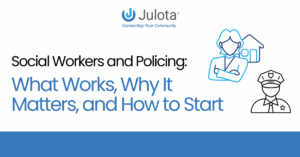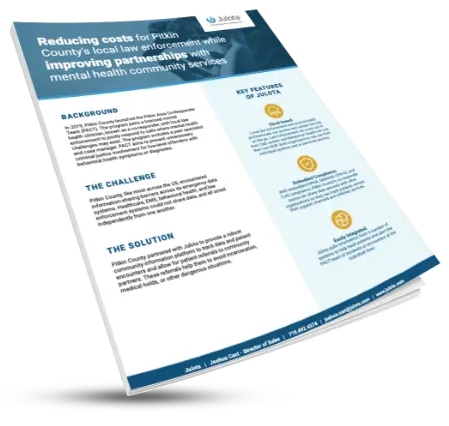
Why Social Workers Belong in Policing
Police have always answered complex calls that are not strictly criminal. Behavioral health crises, domestic violence, welfare checks, aging adults who need support, and families navigating trauma all land on 911. Officers are trained for safety and enforcement. Social workers are trained for assessment, stabilization, linkage to care, and long-term follow-through. Together, they reduce harm and improve outcomes.
Leaders in the field report three consistent gains:
- Better outcomes on scene. Officers secure the scene. Social workers de-escalate, assess, and connect people to services. Many calls do not require a continued law enforcement presence once safety is established.
- Reduced repeat calls. Social workers close the loop. They follow up after the shift ends, coordinate care, and help people navigate housing, treatment, and benefits. Agencies see fewer repeat 911 calls to the same address.
- More officer time for priority crime. When social workers take the long tail of a call, officers return to patrol and investigations. That time shift matters most in cities battling violent crime.
Embedded, Co-Responder, or Referral Only? Pick the Model That Fits Your City
There is no one-size model. Departments generally adopt one of three approaches.
- Embedded model. Social workers are city employees or dedicated staff who work in the station daily. Trust grows quickly because officers and social workers see each other on roll call, share cases, and learn each other’s cadence. Embedded teams can add counseling hours, court advocacy, or case management when staffing allows.
- Co-responder model. A social worker rides or shadows patrol during defined hours. In busy cities, this can be a full-time assignment with shifts and vests. Dispatch sends the police first. When safe, the social worker joins, takes over the human services side, and plans the handoff.
- Referral only model. Officers refer cases to an external agency that follows up later. This approach is better than nothing, but it slows down relationship building within the department. Many agencies start here and evolve into an embedded or co-responder program as results and funding arrive.
The core insight from experienced teams is simple: presence builds trust. Trust between officers and social workers. Trust between the department and community members who come to the station seeking help. The more your social worker is physically present, the faster the program earns buy-in and the faster results compound.
What a Police Social Worker Actually Does
A typical day covers both reactive work and proactive outreach.
- Daily case review. Pull reports with tags like behavioral health, well-being check, suicidal subject, domestic trouble, elder concern, or frequent caller. Prioritize cases for outreach.
- On scene support. When patrol requests help and the scene is safe, social workers take the lead on the human services side. They listen, assess risk, and begin problem solving.
- Follow up and linkage. The day after a crisis, people need help more than ever. Social workers call, visit, and walk clients into community services. They coordinate with hospitals, mobile crisis teams, “living room” models for same day stabilization, township supports, and mental health boards.
- Victim advocacy. In many departments, police social workers also serve victims of crime. They help with orders of protection, court navigation, safety planning, and coordination with the state’s attorney advocates.
- Threat assessment and prevention. Schools and departments convene teams when a person or a post raises a concern. Social workers help assess, plan, and monitor at one week, one month, six months, and one year. The goal is prevention through consistent contact and connection to care.
- Officer wellness and peer support. A healthy culture acknowledges that officers carry a heavy load. Social workers can sit on peer support teams, offer confidential consultations, and normalize help-seeking behavior.
Safety First, Then Specialization
Every practitioner emphasized one principle. Police secure the scene. Social workers enter only when it is safe. Roles are complementary, not competitive. Officers bring scene control, legal authority, and tactical awareness to the scene. Social workers bring clinical assessment, trauma informed communication, and system navigation. On some calls, the rapport between a specific officer and a resident is the strongest lever for success. Good teams read the room, support each other, and let the best connection lead in the moment.
The Domestic Violence Dimension
Domestic calls are among the most stressful and complex. Strong programs integrate:
- Immediate crisis response. De-escalation, emergency safety planning, and shelter connections through local partners.
- Court advocacy. Help survivors secure and understand orders of protection, handle cross-jurisdiction issues, and stay engaged through hearings.
- Longer term support. Link the household to counseling, substance use treatment, parenting help, and financial assistance. Follow ups reduce the chance of return calls and deepen trust.
Threat Assessment that Prevents Harm
Threat assessment is not about hardening buildings alone. It is about noticing, assessing, and supporting people who show concerning behavior. A practical framework includes:
- Clear referral paths from schools, workplaces, and community members.
- A multidisciplinary team that includes the SRO or detective, two mental health professionals, school leaders when applicable, and a social worker who can coordinate follow through.
- Time bound check ins. A plan that continues beyond the news cycle, with outreach at one week, one month, six months, and one year.
Social Workers and Policing Partnerships are the Force Multiplier
No department can do this alone. The most effective teams knit together:
- County mental health boards and township support. Funding, crisis teams, and case management capacity.
- Hospitals and emergency departments. Warm handoffs, same day contacts, and discharge planning that includes the police social work team.
- 24/7 stabilization options. “Living room” programs or crisis centers where people can talk, de-stress, and connect to care without a hospital admission.
- 988 and mobile crisis. Shared protocols so patrol knows when to call, who arrives, and how information flows back.
- Legal aid and victim services. Multilingual support to decode paperwork, immigration issues, and cross border cases.
What to Measure in Social Workers and Policing and Why it Matters
If you want city leaders to invest, bring data and stories. Track both.
Operational metrics
- Repeat calls per address before and after social work contact
- Average officer time on calls where a social worker takes the follow up
- Patrol hours returned to proactive policing
- Referrals completed within seven days and thirty days
- Court attendance rates for domestic violence and other victim advocacy cases
- Time from threat assessment referral to first outreach
- Linkage to treatment, shelter, benefits, or housing
Quality and equity metrics
- Client satisfaction and perceived safety changes
- Use of force incidents on behavioral health calls
- Outcomes by neighborhood to monitor equitable access
- Officer wellness utilization and stigma indicators
Stories that stick
Pair the numbers with brief anonymized vignettes. The resident who finally accepted help after months of psychosis. The survivor who understood her legal rights because a social worker translated and walked with her. The family that stayed connected long enough to stabilize a teen who posted a threat out of distress. Stories are the memory hooks that help councils and communities see the human impact behind the metrics.
Building Your Program: a Step-by-Step Roadmap
- Clarify your “why.” Identify your top three pain points. Examples include frequent behavioral health calls, domestic violence follow through, school related threats, or officer wellness. Your why shapes the model.
- Choose the model. Start embedded if possible. If the budget is tight, begin with a shared or contract social worker, then plan to embed them. Define when a co-response is expected and when a referral is best.
- Fund the first seat. Blend sources. City budget, county mental health boards, township funds, hospital community benefit, grants, and foundation partners. Many departments braid funding with written MOUs.
- Hire for fit. Look for licensed social workers with crisis experience, cultural humility, and collaboration skills. This is chameleon work. People must adapt to various scenes, partners, and personalities within the station.
- Write clear protocols. Safety first. Spell out dispatch criteria, scene clearance, documentation, information sharing, and handoff rules. Include confidentiality guidance that protects clients and builds officer trust.
- Train together. CIT for officers. Ride alongs for social workers. Tabletop exercises for domestic violence, suicide risk, and school threats. Shared language and repetition build muscle memory.
- Integrate community partners. Map services, introduce the team, and create direct points of contact. Decide in advance where you will send people at 2 a.m., what transportation arrangements will be in place, and how updates will be returned to the team.
- Pick technology that connects your community. Your team needs a safe way to share referrals, track cases, and pull outcomes across agencies without duplicating effort or violating privacy.
- Start small, measure, and tell the story. Launch with a focused scope. Collect data from day one, then brief the command staff and council on early wins and lessons learned.
How Julota Supports Social Workers and Policing
Julota is built for cross agency collaboration. Departments and social work partners use it to:
- Create and track referrals in seconds, then see status across agencies without endless emails or spreadsheets.
- Build shared case records that follow a person across police, fire, EMS, behavioral health, hospitals, and community based organizations, with permissions that respect HIPAA, 42 CFR Part 2, and CJIS requirements.
- Coordinate victim advocacy by logging orders of protection, court dates, safety plans, and contacts, so survivors do not fall through the cracks.
- Manage threat incident follow-up with scheduled check-ins at one week, one month, six months, and one year, so prevention plans actually stay on track.
- Integrate with 988, mobile crisis, and “living room” partners to make warm handoffs routine.
- Report what matters with dashboards that show reductions in repeat calls, officer hours returned to patrol, and increased linkage to care. City leaders see the value fast.
When a department says it wants a single place to do the work, a way to stop copying data into spreadsheets, and a platform that actually connects the community, this is where Julota shines.
A Quick Implementation Checklist
- Define your problems to solve and success metrics
- Select embedded, co-responder, or hybrid model
- Secure braided funding and draft MOUs
- Hire the right social worker and establish safety protocols
- Train together and set up a shared language for dispatch and handoff
- Stand up Julota to manage referrals, cases, and reporting
- Launch with a narrow scope, collect data, and expand as wins accumulate
The Bottom Line
Social workers and policing work best when the relationship is built on mutual respect and clear roles. Officers make scenes safe. Social workers stabilize people and systems. Departments that embed social work capacity see fewer repeat calls, better outcomes on high stress incidents, and more time for officers to focus on priority crime. Communities see a department that is human, coordinated, and accountable.
If you are ready to connect your community, streamline referrals, and show measurable impact from day one, we can help. Request a Julota demo and see how agencies like yours are making police social work programs sustainable and effective.


